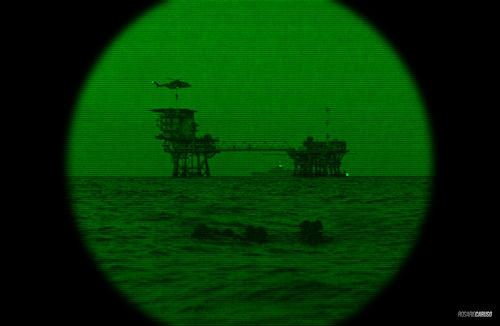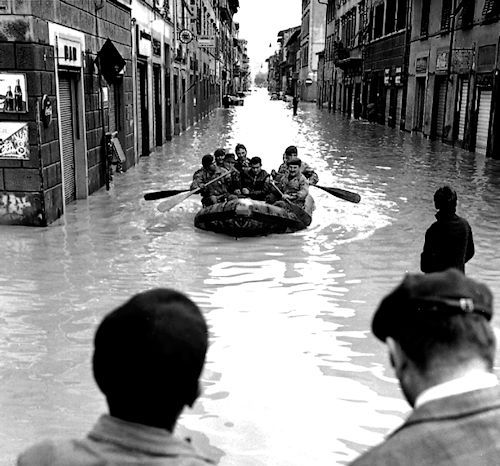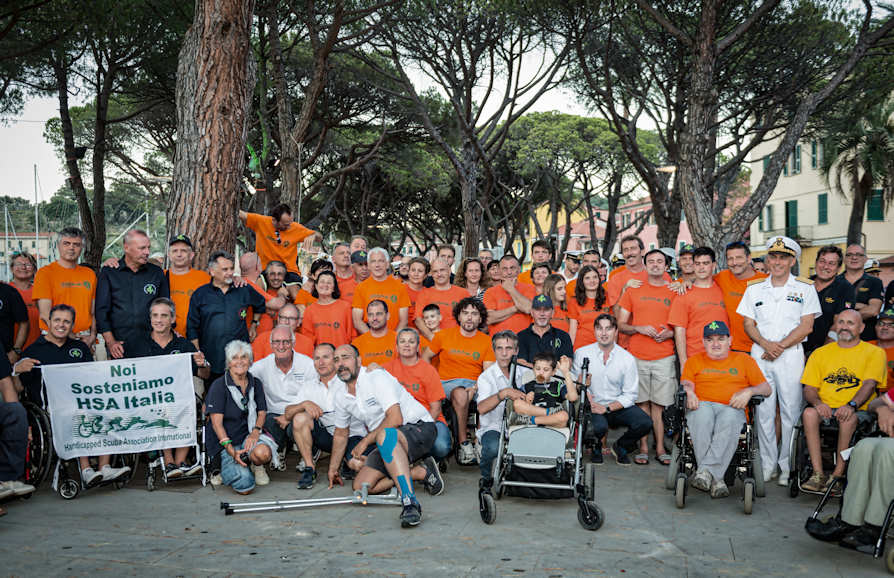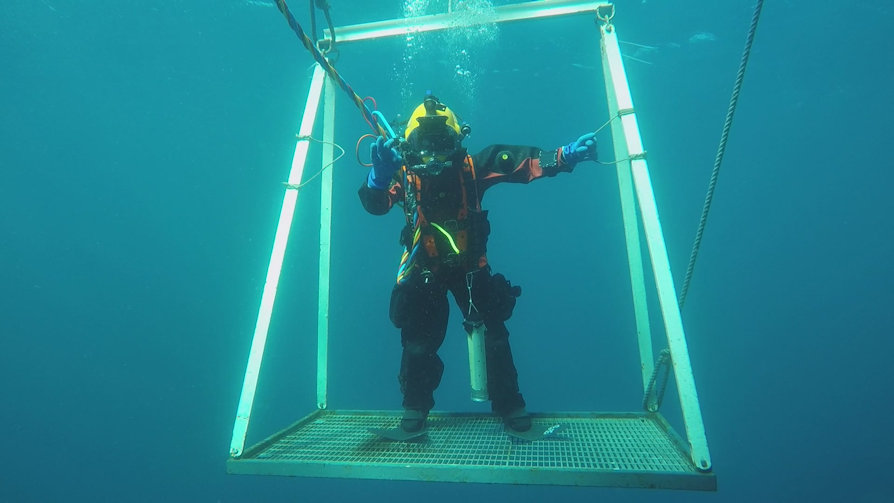"A glorious story. A fundamental present for the security of Italy. An even more important future in a world whose risks are increasingly in need of specialization ": this is the message that Minister Pinotti has dedicated to Comsubin - Underwater and Incursori Grouping - last 23 January. Glorious memory and deeds, specific skills, excellent and efficient preparation, continuous and careful training, most of the time in difficult conditions, spirit of sacrifice and dedication make the Navy Special Forces and the Special Forces of the Navy. Precisely because excellence, joining the Comsubin requires an intense path, which only a select few can overcome. To explain this and to tell us about how versatile and transversal the company is Comsubin, the commander of the Grouping, Rear Admiral Paolo Pezzutti (photo).
The Comsubin today, in its two declinations of excellence GOI and GOS, what expresses the historical values of the past? The technology and the training what kind of evolution have they had to date?
Many years have passed since the birth of the modern underwater took place in Genoa in the 1849 in the Navy of the Kingdom of Sardinia, but the spirit of adventure and daring that animated that distant past and that allowed to generate businesses and heroes whose memory we cherish, is alive today as then at the Varignano. It is perceived by crossing the entrance gate, walking in the square where the flag stands and the motto "FOR THE PATRIA" that gives the reason for every single sacrifice offered, day and night, by the operators of Comsubin.

These values guarantee continuity over time and make Group Operating Groups an always ready, effective and winning tool available to the defense. Integrated with other components of the Navy and those of other Armed Forces, the GOI and the GOS, despite very different institutional tasks, perform the missions entrusted, strong both of the exclusive and extraordinary operational and professional competence in the respective sectors, and of a preparation based on continuous and scrupulous training that is conducted under the most difficult conditions.
I methods of work, whose cornerstones remain those of the past, must obviously evolve in parallel with the development of procedures and technological innovation of means and armaments. Today in our organization there is a department that today is called the Office of Studies, but which at the time of the companies of the Assault Vehicles was called the Diving Center, which has the task of researching and experimenting all the scientific and technical aspects necessary for innovation. of the materials and capabilities of our Operational Groups.
In this period many young people participated in the competition announcement to enter the Naval Academy. What does it mean to become a "Green Basque" or a "Blue Basque" and how do you become one?
It is not easy to describe the pride and the sense of belonging to the Department that proves an Incursor or a Palombaro of Varignano; it can be guessed from their looks, their gestures. Living daily with them we discover feelings of solidarity, founded on the ethical and historical traditions of their category, which unites them and makes them members of the same family. This "spirit of body", the foundation of Comsubin's high operational capacity, is the first answer I can give you.
 Shooting the "Green Basque" from Incursor means entering a department, heir to the heroes of the past, formed by men who, through their exploits, wrote the most epic pages in the history of our Armed Forces. Being an Incursor means being part of the Navy Special Forces, a body with wide margins of capacity, flexibility and operational autonomy. The GOI is an instrument of great value and effectiveness in the management of operational situations with political and strategic implications in complex international scenarios also characterized by the continuous terrorist threat, perfectly integrated in the inter-operations segment of special operations.
Shooting the "Green Basque" from Incursor means entering a department, heir to the heroes of the past, formed by men who, through their exploits, wrote the most epic pages in the history of our Armed Forces. Being an Incursor means being part of the Navy Special Forces, a body with wide margins of capacity, flexibility and operational autonomy. The GOI is an instrument of great value and effectiveness in the management of operational situations with political and strategic implications in complex international scenarios also characterized by the continuous terrorist threat, perfectly integrated in the inter-operations segment of special operations.
To wear the "Blue Basque" from Palombaro means, instead, belong to a group of divers known all over the world and that, recently, has intervened in every maritime emergency situation that has lived our country. The GOS is a department of great professionalism able to intervene with great speed and effectiveness in rescue activities to submarines, reclamation of ordnance or underwater works of all kinds.
The young officers who, after finishing the Academy, want to become Incursori or Scombari, if results suitable for medical examinations preparatory to the attendance of the relative qualification courses, are centralized to Comsubin in January of each year to start the following training courses almost a year each.
Raider Enabling Course

Il entry test: it is not an impassable barrier, even if the physical form is a requirement that the aspiring raider will have to dedicate a few hours of his day, even during preparation for the course. The selective tests consist of a dip of feet from a 5 trampoline, a swimming trial and other physical checks that are sufficiently described on the Navy site. After the entrance test, the raider course begins, divided into four phases, which represents for the students the first step of a basic preparation that will enable them to enter the operational teams of the Incursori Operating Group where they will integrate their knowledge and skills. and where they will acquire "combat readiness".
La first stage, ground combat (duration 12 weeks), involves passing numerous physical tests and training in the use of weapons and equipment, knowledge of the topography and more generally everything concerning the individual and patrol tactical movement on the ground. Furthermore, in this phase, self-defense techniques begin to be developed and the first rudiments relating to movements on a rock wall are acquired, which will be perfected later in the course. The typical day begins with running and gymnastics and continues with theoretical lessons and practical day and night activities. As new operational skills are acquired, physical preparation also increases and, obviously, the difficulties to be overcome. The training becomes more and more intense, with fast gears in heavy weight up to a final test of 40 kilometers of night walking to be carried out in no more than 7 hours, with a load of 18 kilos of equipment.
 La second stage, fighting in water (duration 13 weeks), is the hardest and most selective phase of the course. The activity is mainly dedicated to swimming on the surface and underwater, both day and night. In this phase the students will have to demonstrate that they are comfortable underwater and know how to cover long distances swimming with their equipment. In this phase the student also acquires the ability to conduct fast dinghies and is subjected to an examination during which he will have to demonstrate that he has learned, among other things, notions of boating and aerial photography.
La second stage, fighting in water (duration 13 weeks), is the hardest and most selective phase of the course. The activity is mainly dedicated to swimming on the surface and underwater, both day and night. In this phase the students will have to demonstrate that they are comfortable underwater and know how to cover long distances swimming with their equipment. In this phase the student also acquires the ability to conduct fast dinghies and is subjected to an examination during which he will have to demonstrate that he has learned, among other things, notions of boating and aerial photography.
La third stage is the amphibious one (duration 12 weeks): at this stage of the course the students will have to learn the tactics and techniques to move from sea to land and vice versa and will perfect their knowledge with the use of different types of special weapons supplied, gaining experience both in targeted shooting and in instinctive / operational shooting. They will also learn to use explosives and demolition charges as well as to operate from / with helicopters. This phase concludes with three nocturnal reconnaissance or amphibious attack exercises against coastal targets and / or naval units.
In fourth and last phase of the course, conduct of operations (duration 15 weeks), students must demonstrate knowledge of how to integrate what they have learned and put it into practice in every operating environment, planning and carrying out a complex final exercise, as well as submitting to final exams that require a written and oral examination of what learned during the course. Those who are judged eligible receive, during a solemn ceremony, the patent and the ambition "Basque Verde" of the raiders and transit through the ranks of the Operating Group Incursori.
Underwater Qualification Course (Palombari)
 Il entry testCandidates are subjected to a series of physical tests and a compensation test in a hyperbaric chamber which, if exceeded, allows to arrive at the next aquatic checks. During these last tests, carried out in the swimming pool, it is necessary to demonstrate to be able to perform some simple maneuvers, previously described by the instructors, which are listed on the Navy site. After the entrance test, the Palombari course begins, divided into four phases, through which the students are progressively trained in the use of different types of scuba diving and diving systems, as well as the execution of underwater works, also performed with the use of explosives.
Il entry testCandidates are subjected to a series of physical tests and a compensation test in a hyperbaric chamber which, if exceeded, allows to arrive at the next aquatic checks. During these last tests, carried out in the swimming pool, it is necessary to demonstrate to be able to perform some simple maneuvers, previously described by the instructors, which are listed on the Navy site. After the entrance test, the Palombari course begins, divided into four phases, through which the students are progressively trained in the use of different types of scuba diving and diving systems, as well as the execution of underwater works, also performed with the use of explosives.
In first stage, air up to 15 meters, the students participate in an intense morning physical training program which follows the activity in the water with the air breathing apparatus, aimed at the execution of simple work on the bottom and on the hull of the ships up to the depth of 15 meters. The very intense daytime and night diving activity is used by the student to increase confidence in the marine environment. This phase represents a fundamental formative moment for the physical preparation necessary for the continuation of the course, subsequently much more demanding.

Follows the second stage: use of diving equipment up to 40 meters. Course users begin to employ a wide range of diving equipment ranging from Nitrox (Nitrogen / Oxygen), the so-called rebreather, to pure oxygen self-contained breathing apparatus, through complex and demanding immersion systems for work heavy divers or for activities in polluted environments. The students become familiar with the execution of increasingly demanding underwater works, such as harness and recovery with sunken hull lifting balls, underwater welding and cutting with industrial systems, research on the bottom of objects using portable sonar and metal detector. The instructors gradually modulate the activity until everyone reaches the maximum operational expression of the equipment both day and night.
La third stage, use of equipment for diving up to 60 meters, allows students to use the self-contained breathing apparatus used in the previous phases up to the limit of the operating shares of the same. At the end of this training period the visitors will be able to use all the equipment for air immersion up to 60 meters, NITROX rebreathers up to 54 meters and, at those altitudes, perform complex and articulated underwater works.
In fourth phase, EOD Sub, students learn to use a wide range of explosives, both on land and at sea, as a working tool to conduct the operations of neutralization of explosive devices in maritime contexts, one of the tasks of institute of the body of divers in the Marina. Finally, in addition to obtaining the qualification to conduct the boats within 12 miles from the coast, the visitors support the theoretical exams at the end of the course. Final act will be the traditional patenting ceremony during which it is allowed to wear the "Blue Basque" and transit through the ranks of the Submarine Operating Group, where the new divers will consolidate and refine their preparation.
The deeds of heroes of the past are known more, while nothing is known of today's actions. It may be due to the first rule of the Decalogue of the Raiders, which was also read to the 10 new patented last 23 January, which reads "shut up". How important is silence, understood as confidentiality and lack of clamor in your profession? How much are the rules of the Decalogue applied today, which is a deontological and ethical code for you?
 As I anticipated, our values are based on what our predecessors taught us. "Men who shy away from honors and praises dedicate themselves entirely to the service of their country, without any reservation; their complete and absolute offer is the result of an instinctive and essential sentiment: the love of Fatherland "as a commander of the World War II assault media wrote in one of his books.
As I anticipated, our values are based on what our predecessors taught us. "Men who shy away from honors and praises dedicate themselves entirely to the service of their country, without any reservation; their complete and absolute offer is the result of an instinctive and essential sentiment: the love of Fatherland "as a commander of the World War II assault media wrote in one of his books.
This is still the spirit with which we live and work in Varignano. With ingenuity, initiative, team spirit to experiment, develop the means and tools necessary to apply operational concepts and fulfill the assigned missions. With the determination to train men who have the qualities of the heroes who preceded them: humility, discipline, dignity, calm, courage, passion and the spirit of service to the extreme personal sacrifice.
The very selective training is aimed at bringing out the qualities of man, the ethical values that a raider must have over hardship and physical performance. It is the pride and duty of an incursor to ensure that the values that inspired the men who have preceded us are guarded. As well as the dictates of the decalogue of the raider, written in the 1943 and as ever current, must be kept and applied with humility and full awareness of their meaning. "Silence", then as for us today, constitutes a virtue and a fundamental and indispensable component for our every action. The rules of conduct that are inspired by the Decalogue are rules of private and professional life for GOI Incursors. Comsubin's men are part of us.
Services for the community have long been at the center of the activities of the Navy. From this point of view, the Comsubin is not far behind: from scientific research to community activities, just to name a few. How important is it to combine the military and the civil world?
 The Varignano operators have always worked for the community. Suffice it to think of the titanic work of reactivating the ports conducted by the Scombari immediately after the war, rendered unacceptable by the Allied bombing and by the destruction perpetrated by the fleeing Germans, or by the intervention of the Incursori in the Florence flood (1966), in the earthquakes of Friuli (1976) and Irpinia (1980) or in the operation that allowed the deviation of the lava flow of Etna (1992).
The Varignano operators have always worked for the community. Suffice it to think of the titanic work of reactivating the ports conducted by the Scombari immediately after the war, rendered unacceptable by the Allied bombing and by the destruction perpetrated by the fleeing Germans, or by the intervention of the Incursori in the Florence flood (1966), in the earthquakes of Friuli (1976) and Irpinia (1980) or in the operation that allowed the deviation of the lava flow of Etna (1992).
The combination of the Operational Groups, the Schools Group, which allows us to train the new divers and Incursori at home, and the Research Department of which I have already mentioned, is the winning weapon of Comsubin, but above all generates an induced which the civil world also benefits.
I refer, for example, to the ability of divers to operate underwater at great depths, made many times available to the judiciary and the MiBACT, to carry out research and rescue, as happened in the emergence of the Costa Concordia to the island of Giglio and waters of the port of Genoa, among the ruins of the tower pilots, or to reclaim the seabed from the countless explosive remnants of war residues that, only in 2016, have exceeded the share of 12.000. Recently, these men have distinguished themselves in the activities of recovery of the countless bodies resulting from the most dramatic shipwrecks of the migratory phenomenon: in Lampedusa, in October of 2013, and in the Central Mediterranean, following the sinking to 370 meters of depth of a fishing boat with on board over 700 people, occurred on the night of 18 2015 April.
Then there are the research carried out in the Underwater and Hyperbaric Medicine conducted in Varignano in the early years of the '900 and now the Department of Underwater Physiology of the Office continues to develop. This incessant scientific activity has meant that in the main hospital centers around the world was installed a Decompression Chamber (also designed by the diver Alberto Gianni in 1916 with the original name of Cassa Disazotatrice) to conduct treatments of oxygen hyperbaric therapy, which today allow you to save many lives. Medical activity that has recently been made available to the civil patients of the ASL of La Spezia who, daily, are brought to our Hyperbaric Center, built to support the underwater operations of our men.
 But it does not end here, because the research carried out in the medical field has allowed us to start a university master's degree in Underwater and Hyperbaric Medicine with the University of Insubria of Varese, whose opening is scheduled for the month of February, as well as to maintain close ties with other Italian universities that are very attracted by the maritime specificity of Comsubin. We also have in the future a project to create a hyperbaric simulator that will allow Comsubin and the Navy to strengthen the network of relationships with universities, industry and other Armed Forces in the field of underwater physiology, research and testing of underwater materials, procedures operating GOS and GOI, training.
But it does not end here, because the research carried out in the medical field has allowed us to start a university master's degree in Underwater and Hyperbaric Medicine with the University of Insubria of Varese, whose opening is scheduled for the month of February, as well as to maintain close ties with other Italian universities that are very attracted by the maritime specificity of Comsubin. We also have in the future a project to create a hyperbaric simulator that will allow Comsubin and the Navy to strengthen the network of relationships with universities, industry and other Armed Forces in the field of underwater physiology, research and testing of underwater materials, procedures operating GOS and GOI, training.
Lastly, I would like to mention the activity with the disabled divers that we perform every year during the last week of July: well, that activity represents the most beautiful day of the year, the moment when we live the sea with serenity and joy that these friends can give.
To conclude, I believe that the “Teseo Tesei” Underwater and Incursors Group has a natural vocation to combine the military with the civilian world. We are more and more open with the belief that our skills, experiences and knowledge can and should be made available to the civil community, always putting the good of the community first.


 (Photo: Marina Military)
(Photo: Marina Military)












